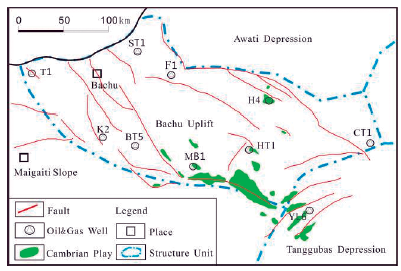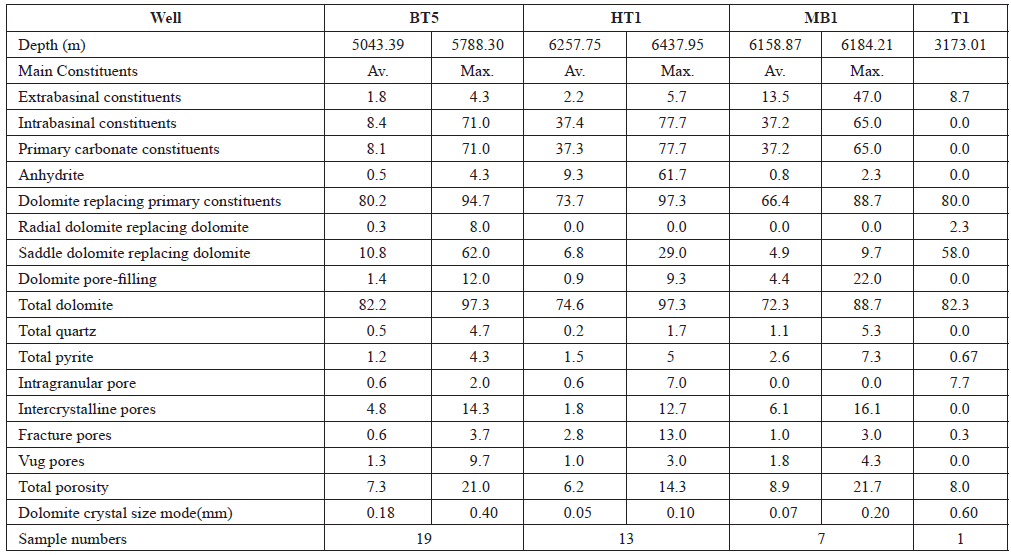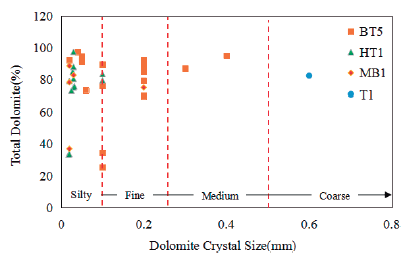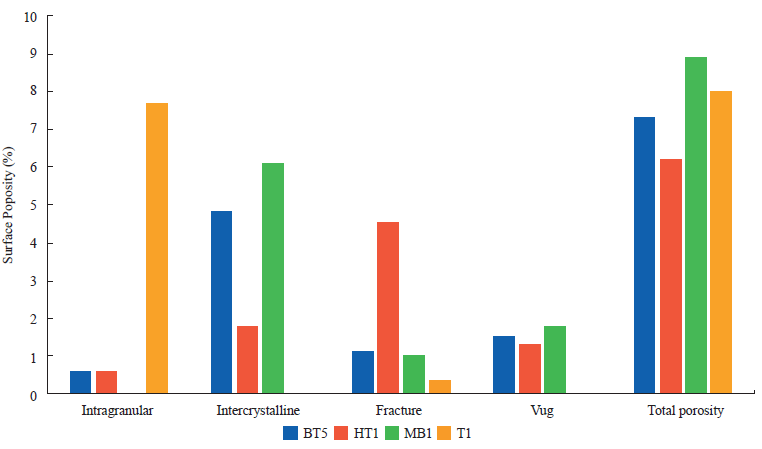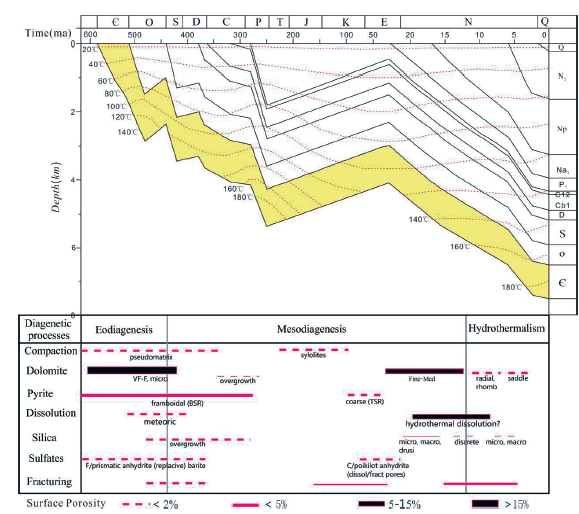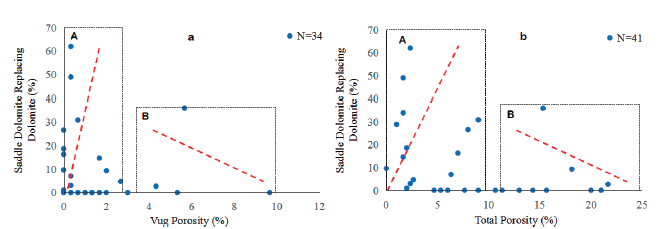Introduction
With the development of oil and gas exploration in the Tarim Basin, researchers have increasingly focused on the prospect of dolostone in the upper Cambrian salt in the Bachu uplift (He, 2013; Yang, Liu, Tian, Wanbin & Zhu, 2011; Jiao et al., 2011; Cai, Li, Quian & Zhang, 2010; Chen, Wang, Meng & Zheng, 2002) . Many gas logging anomalies appeared in the HT1, BT5, MB1, and T1 wells drilled by the Lower Qiulitage Group in the upper Cambrian system (Fig. 1), indicating that the Lower Qiulitage Group reservoir could be well developed (Huang, Jiang & Ma, 2014; Zhu, Meng, Jin, Liu & Hu, 2015; Cai, Mao, Qian, Chen & You, 2009). But, due to the limitation of burial depth and exploration conditions, and to the lack of drilling data, the reservoir characteristics and genesis of the Lower Qiulitage Group were doubtful, which restricts further explorations of the upper Cambrian. In this paper, the reservoir characteristics and genetic model of the Lower Qiulitage Group are studied through core observation and petrochemical analysis of the upper Cambrian samples, to provide theoretical support for further risk exploration in the Bachu uplift.
Reservoir Properties Petrologic features
Based on core observation of BT5, H1, MB1, and T1 in the Bachu uplift, combined with identification of 40 thin rock sections (Table 1), it was found that the crystalline dolomite of the Lower Qiulitage Group was developed with an average dolomite content of 72.3-82.2%, followed by micrite dolomite. Residual granular dolostone developed relatively less in the formation, with content between 1.8% and 13.5%. The particles' residual structure was clearly observed under the microscope due to the incomplete dolomitization and recrystallization in the Bachu uplift (Fig. 2a). Some intergranular and vug pores were filled with anhydrite, secondary quartz mineral, and pyrites; the content of anhydrite was between 0.5% and 0.9%, the secondary quartz was 0.2%, and pyrite was between 0.67% and 2.6%.
Crystal dolomite
The crystalline dolomites were mainly formed by metasomatism or recrystallization. Because the original rocks have undergone thorough dolomitization, it was difficult to recognize their original structure (Liu et al., 2010). The Cambrian crystalline dolomites in Bachu uplift are characterized by silty crystalline, fine crystalline, and a med-coarse crystalline structure (Fig. 2), as the distribution of silty dolomite in Bachu is relatively low, mainly in the eastern area. In the MB1 well and H1 well, dolomite crystal is in its anhedral-subhedral form, with a muddy crystal surface. The crystal dolomites are in mosaic contact, and the intercrystalline pores and dissolved pores are not developed. The surface porosity is low (Fig. 3a), and a number of fractures and stylolites were developed. The fracture was mostly filled with dolomite and organic matter (Fig. 3b), and needle pores were formed by later dissolution on the core.
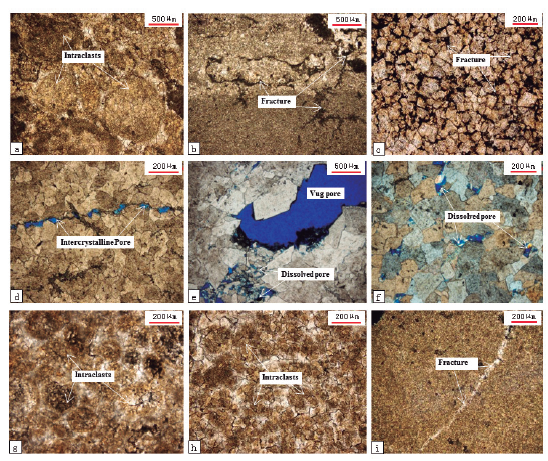
Figure 3 Microscopic characteristics of crystalline dolostone of Lower Qiulitage Group a. Residual granular dolostone, MB1, 5632m, Є 3ql, plane polarized light, x50; b. Silty dolostone, BT5, 4743.37m, Є3ql, plane polarized light, x100; c. Fine dolostone, dolomite was with euhedral, intergranular pores filled by organic matter, MB1, 530m, Є 3ql, plane polarized light, x100; d. Fine-middle dolomite, dissolved in beaded, BT5, 4812.9m, E3ql, blue cast, plane polarized light, x50; e. Med-coarse dolostone, vug pore, and intergranular pore developed, BT5, Є 3ql, 4812.9m, blue cast, plane polarized light; f. Med-coarse dolostone, a small amount of unfilled intragranular and intergranular pore developed, BT5, Є 3ql, 4812.9m, blue cast, plane polarized light, x50; g. Residual debris dolostone, showing a large amount of residual particle structure, intergranular pores and fractures filled with organic matter, HT1, G3ql, 5816.8m, plane polarized light, x50; h. Residual debris dolomite with a large amount of the residual particle structure, BT5, 4739.32m, Є 3ql, plane polarized light, x50; i. Micrite dolostone and fracture filled with dolomites, MB1, 5658m, Є3ql, plane polarized light, x50)
Fine dolomites are widely distributed in the Bachu uplift, mostly in anhedral-subhedral form. The crystal planes are turbid, and the crystals often appear with a concave-convex contact. Some of them can be seen in the foggy center with a bright edge or dolomite ring structure, and occasionally with a residual grain phantom structure. The original intercrystalline pores and fractures were filled with organic matter (Fig. 3c). The fine dolomite with higher euhedral was distributed in the dissolution pores or at the edge of the fracture, and the intercrystalline pores and dissolution pores are relatively developed (Fig. 3d). The medium-coarse crystalline dolomites were mainly developed in Well T1 and BT5 in the west Bachu uplift, mostly with anhedral-subhedral form. The crystal surface is turbid, and the intercrystalline pores and intercrystalline dissolved pores are not developed (Fig. 3e). The medium-coarse dolomites were greatly affected by the later dissolution, and plenty of large dissolved pores were formed (Fig. 3f). The fine dolomite with higher euhedral was distributed in the dissolution pores, or at the edge of the fracture, and the intercrystalline pores and dissolved pores are relatively developed. Where the dissolution was intense, it can be seen that the dolomite crystals are partially dissolved to form intragranular dissolved pores. On the whole, the dolostone has obvious differences in distribution. In the west Bachu uplift, the fine and med-coarse dolomite are dominant, while the silty and fine dolomite are developed in the east.
Residual granular dolomite
The granulated dolomites in Bachu are mainly composed of sand debris, gravel, and oolitic grains (Figs. 3g, 3h). Some particles are mainly composed of mud microcrystalline dolomite, which was rich in organic matter. Some particles recrystallized to form silty dolomite. The crystal grains are larger, the outline of the particles is not clear, and the remaining particles retain the original structure.
Micrite dolomite
The micrite dolomite was relatively developed, and the lamellar structure and birds-eye structure are both visible. A small amount of fractures and stylolite was developed, with dissolved vugs mostly filled with dolomite, calcite, and anhydrite. The dissolved pores were developed, but most of them were filled or semi-filled later. The crystal dolomites had mosaic contact, and the porosity and permeability are very low.
Porosity and permeability
The reservoir property analysis of 26 samples from the Lower Qiulitage Group showed that the porosity ranged from 0.14% to 6.7% with an average value of 2.28% (Fig. 4a). The permeability ranged from (0.01-4.5)10-3m2, with an average value of 1.1210-3m2, so it was defined as a low porosity and low permeability reservoir. Reservoir heterogeneity was strong and the correlation between porosity and permeability is not obvious. The fine dolomite reservoir had higher porosity and a better pore-permeability relationship according to the crystal type (Fig. 4b).
Reservoir Space
Microscopic analysis demonstrated that the reservoir space was of various types, and that the intercrystalline pores and the intercrystalline dissolved pores were relatively developed (Figs. 5a, 5b, 5c). The morphology of the intercrystalline dissolved pores are irregular, with many harbors, and some of the pores and vugs were filled with quartz and dolomite (Figs. 5d, 5e, 5f). The scale of intracrystalline dissolved pores was small, and the contribution to the reservoir space was limited. A large number of dissolution pores were developed in the middle and lower sections of the Lower Qiulitage Group and showed in beaded and honeycomb form on the core. The pore sizes were different, mostly 0.1-2mm, in various states such as unfilled, semi-filled, and fully filled. Unfilled dissolution holes are the main reservoir space (Figs. 5d, 5f). The statistics of the dissolved pores of the Lower Qiulitage Group showed that the distribution of reservoir space was heterogeneous (Fig. 6), mainly composed of dissolved pores and fractures. Some of the pores visible on the core were filled with dolomites and calcite, mainly semi-filled vugs. The wells of Fang1 and HT1 are characterized by dissolved pores and mainly dominated by small vugs.
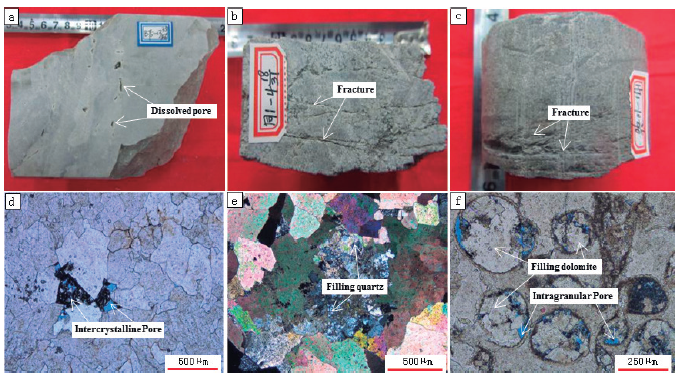
Figure 5 Reservoir types of the Lower Qiulitage Group of the Bachu uplift a. Shallow gray silty dolostone with dissolved pore and fracture, BT5, 4811.61 -4811.71m, Є3ql; b. Gray fine dolostone with three very thin horizontal fractures. T1, 3174.2m, Є 3ql. c. Gravel-bearing dolostone with small dissolved pores along the thin fracture. HT1, 6163.85, Є3ql. d. Med-coarse dolostone with dissolved pore semi-filled with pyrite. BT5, 4739.88m, Є3ql, plane polarized light, x10. e. Med-coarse dolostone with intragranular and intercrystalline pore filled with quartz. BT5, Є3ql, 3173.01m, cross-polarized light, x5. f. Intragranular and intercrystalline pore developed, semi-filled with late dolomites. BT5, 6162.45m, Є 3ql,x10.)
Discussion Dolomitization
The dolomite genesis is an important part of the study of dolomite reservoirs (Zhu, Zhang, Xie, Huang & He, 2011; Han, Li & Shen, 2017; Liu, Huang, Wang & Shi, 2016). The reservoirs of the Lower Qiulitage Group in the Bachu uplift were greatly modified by the dolomitization, with complex causes (Peng, Cao, Li, Xia & Liu, 2018). According to the petrological characteristics and geochemical test results (Huang, Liu, Ye & Li, 2013; Zhang et al., 2009; Chen, Zhou & Yang, 2009), the characteristics of buried and tectonic hydrothermal dolomitization of the Lower Qiulitage Group dolomite are more obvious.
Buried dolomitization
The crystal structure of the Lower Qiulitage Group and the residual granular dolomite are relatively developed. The dolomite grains mostly appeared as anhedral-subhedral with a foggy heart and bright edge structure, and the grain phantoms are more obvious (Fig. 7a). Under cathode luminescence, the matrix dolomite shows a dark red light, while the dolomite ring and spray cement shows a bright red color (Figs. 7b, 7c) with high luminescence intensity, indicating that there is a certain difference between late diagenetic fluid and the early stage.
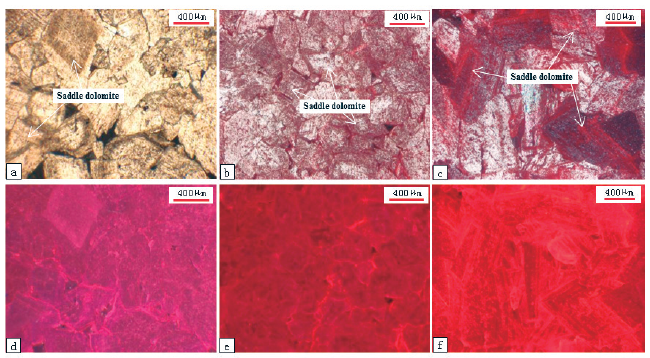
Figure 7 Cathode luminescence characteristics of bottom Qiulitage group (a, d. Med-coarse dolostone with developed intergranular pores, vugs filled with dolomites and quartz, and dolomite with purple light, BT5, G3ql, 4809.09m, cathode luminescence, x40. b, e. Fine dolostone with intergranular pores and dolomite with dark red light, BT5, Є3ql, 4806.85m, cathode luminescence, x 40. c, f. Vug pore filled with medium dolomites with bright red light, with obvious ring texture, BT5, Є 3ql, 4806.85m, cathode luminescence, x 40.)
Trace element analysis showed that the Mn content of silty and fine-medium dolomites was slightly higher than that of micrite dolomite, the Sr content was significantly lower (Fig. 8a), and the Fe and Mn contents were increased (Fig. 8b). This indicates that the dolomite was formed in the burial environment, proving that they were formed in a shallow burial diagenetic stage. Carbon and oxygen isotope measurements show that the carbon-oxygen isotopes of various crystalline dolomites have no distinct differentiation (Fig. 9a), and the whole has a negative S13C value bias and a S180 value greater than -9%o, close to that of paleo-seawater (Zhou et al., 2012). This is combined with the empirical formula proposed by Keith and Weber (Keith & Weber, 1964):

Figure 8 Element content of Fe, Mn, and Sr in the dolomite of the Lower Qiulitage Group (a. Characteristics of trace elements in Sr and Mn of dolomite; b. Characteristics of trace elements in Fe and Mn of dolomite.)
(δ 13 C, δ 18 O belong to the PDB standard; a=2.048, b=0.489; Z≥120 is marine facies, Z<120 is freshwater facies)
The Z values of the residual dolostone and fine-med dolomite in the study area are both greater than 120, indicating that the dolomite of the Lower Qiulitage Group was mainly influenced by marine fluid in the early diagenesis. Strontium isotope analysis shows that the 87Sr/86Sr value of mud microcrystalline dolomite and residual granular dolomite is similar to that of Cambrian seawater (Fig. 9b). Due to the influence of the diagenetic modification intensity, the 87Sr/86Sr value of silty dolomite is obviously higher than that of Cambrian sea water. It is indicated that the dolomitization fluid was residual seawater during the shallow burial period.
Hydrothermal dolomitization
In recent years, hydrothermal dolomitization has attracted more and more attention, and its impact on reservoirs has been increasingly valued (Boni, Parente, Bechstadt, De Vivo & Iannace, 2000; Ma et al, 2009; He, Liu & Qin, 2010). It is generally believed that saddle dolomite can be used as the main indicator of structural hydrothermal dolomite (Li, Jiao, Wu, Rong & Wang, 2008). Petrological observation of the Lower Qiulitage Group in Bachu uplift shows that saddle dolomite develops in reservoir rocks (Table 1). The average content is between 4.9% and 10.8%, most of which is fine-medium crystalline and close mosaic contact. Under cathodoluminescence, the dolomites are bright red with dark fringes (Fig. 7c) and the ring-like structure is obvious. The intergranular pores are filled with quartz and illite (Fig. 7a), and the calcination and gypsum are generally developed, which indicates that the formation has been subjected to obvious hydrothermal dolomitization.
Trace element analysis showed that the filling dolomite had a higher Mn content and a lower Sr content, indicating that it was formed in a deep burial reduction environment. Carbon and oxygen isotopes show that the S18 OPDB values of the Lower Qiulitage Group crystal dolomite and granular dolostone have an obvious negative bias (Fig. 9a). Likewise, a large amount of siliceous filling observed under the microscope indicates that it was more likely to be modified by hydrothermal fluid. The distribution pattern of rare earth elements shows that there are obvious positive anomalies of Ce and Eu in different crystalline dolomites (Fig.10), which confirms they were modified by hydrothermal fluids.
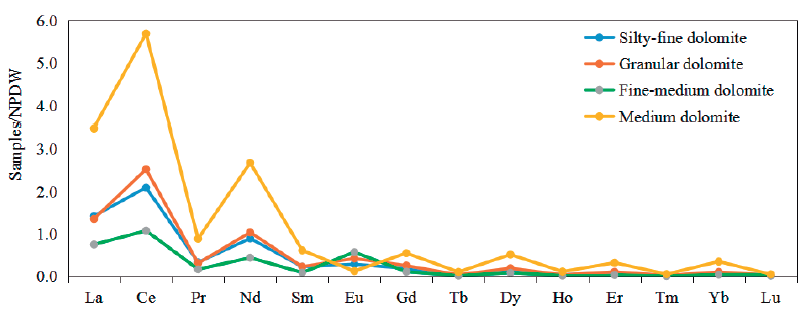
Figure 10 Normalized pattern (NPDW) of rare elements of dolostone in the Lower Qiulitage Group (part of the data from the Northwest Bureau of SINOPEC)
The homogenization temperature of the two-phase inclusions of the distributed saddle dolomites is 100 °C [22]. The buried history map of BT5 in Bachu shows that the depth of the reservoir buried in the Himalayan period is more than 7000 meters, and the maximum temperature of buried depth reaches 180-200 °C. It is shown that the formation of the hydrothermal transport system is easily affected by basement faults (Li et al., 2016). According to the comprehensive petrological characteristics and geochemical tests, it can be seen that the hydrothermal action characteristics of the Lower Qiulitage Group are obvious. The magnesia-rich hydrothermal fluid mainly invades the well-permeability surrounding rock, along with the fault system, and formed hydrothermal dolomite (Cai, Mei, Li & Zeng, 1997). The effect of the hydrothermal was controlled by the deep fault system, and the distribution was relatively limited.
Dissolution of Reservoir
Freshwater dissolution
The diagenetic evolution of carbonate rocks suggests that the atmospheric freshwater dissolution occurs mainly in the eodiagenesis and mostly through selective dissolution. It was observed that some unstable minerals or cement dissolved into intragranular dissolved pores and molded pores, developed in BT5 and HT1 in the Bachu uplift (Figs. 4d, 4f). These early dissolution pores provided the main seepage channels for the diagenetic fluids entering the rocks during the burial period, but they were mostly filled with the later diagenetic cement (Fig. 5f). So, they are less effective and have little significance for the formation of reservoirs.
Burial dissolution
It can be seen that the Lower Qiulitage Group is in the stage of continuous subsidence from the regional burial history chart (Fig. 11), there is no obvious exposure and denudation in the burial stage, and the formation of dissolution holes should be relatively late. The existing studies show that the pore development of carbonate reservoirs in the deep burial stage is mostly related to acidic fluids, and the deep acidic fluids in the deeply buried stage are mainly organic acids and CO2 (Jiang et al., 2008). Some scholars believe that the dissolution of organic acid fluids to reservoirs was limited in a closed environment (Ehrenberg, Walderhaug & Bjtprlykke, 2012; Ehrenberg, & Bjtprlykke, 2016). At the same time, according to regional data, the Cambrian source rocks in the Bachu Uplift are not developed (Yang et al., 2017). Organic acids should not be the cause of vug pores in the Lower Qiulitage Group. In recent years, many scholars have paid attention to the influence of CO2 in hydrothermal fluid on carbonate reservoirs (Biehl et al., 2016).
Zhu Dongya studied the fluids in the Permian igneous rocks in the Central and Northern Tarim Basin and showed that CO2 was predominant in the gases released from igneous rocks, up to 91.47% (Zhu, Meng, Xie & Jin, 2011). Liu Wei collected fluorite and calcite samples in the Xikeer outcrop area of Bachu at the western margin of the Tarim Basin and analyzed the fluid inclusion composition by Laser Raman Microprobe, finding that a large amount of CO2 existed in fluids during hydrothermal activities (Liu et al., 2016). According to the statistics of the reservoir surface porosity (Figs. 12a, 12b), in that range of less than 4% of porosity, the content of the saddle dolomites is slightly positively related to the vug pore, indicating that the corrosion effect has a significant transformation effect on the reservoir. And Large pores are easily filled with authigenic minerals, such as area B in the Figure 12b. The content of saddle dolomite formed by hydrothermal interaction is still positively correlated with porosity and fractures, which indicates that the early hydrothermal dissolution has a significant effect on the increase of reservoir porosity. In this paper, it is considered that the CO2 acid dissolution caused by hydrothermal fluids in the deeply buried environment may be an important reason for the increase of the buried porosity of reservoirs.
Genesis of crystal dolomite reservoir
The reservoir of the Lower Qiulitage Group in Bachu is dominated by crystal dolomite. Due to the lack of drilling and coring, the formation evolution of the reservoir is unclear. Some scholars believe that the reservoir of the Lower Qiulitage Group in this area is affected by sea level exposure and that the Karst caves developed belong to the Karst dolomite reservoir (Zhu et al., 2011; Huang et al., 2016), while other scholars believe that the reservoir was greatly altered by diagenesis (Yang et al., 2011). Under the constraints of buried history, the sequence of reservoir genesis and evolution of the Lower Qiulitage Group has been established by combining reservoir void characteristics and surface porosity identification (Fig. 11).
The restricted platform environment developed in the late Cambrian in Bachu (Ni, Chen, Zhu, Yang & Xiong, 2015; He, Peng, Shao, Gao & Shi, 2002). The sediments are dominated by micrite. Gypsum and other evaporative minerals are common in gray sediments. During the eodiagenesis period, the formation of silty dolomite was promoted by the shallow burial dolomitization, while the crystals were mainly anhedral-subhedral and intergranular pores developed (Figs. 2e, 2f). In this stage, gypsum nodules are easily dissolved by atmospheric fresh water to form a small number of gypsum molds (Zheng, Shen & Liu, 2013).
With the increase of the buried depth, the reservoir enters the mesodiagenesis stage, and the compaction strengthens to form the suture structure. The late tectonic uplift of the middle diagenesis results in the generation of fractures, promoting the burial dolomitization and formation of fine-med dolomites. The cements are mainly siliceous and sporadic pyrite. The reservoir rocks entered the hydrothermal transformation stage during the Himalayan period, which was affected by the basement fracture. The CO2 acid gas was brought by the hydrothermal solution under high temperature and high-pressure conditions (Wang et al., 2016), the residual pores were dissolved along the seepage channels such as fractures and intergranular solution pores, and the residual pores were corroded and altered along the seepage channels such as fractures and intergranular solution pores. The formation of a large number of secondary pores is the key event for the formation of high-quality reservoirs. Hydrothermal dolomitization promotes the development of saddle dolomite. In the late hydrothermal stage, the filling of quartz and anhydrite produced locally reduced the reservoir space to a certain extent and formed the present-day grain dolomite reservoir. Based on the above research, it is believed that the Lower Qiulitage Group develops crystal dolomite reservoirs under the limited platform. But it is greatly affected by burial and hydrothermal transformation. The reservoir quality of dolomite reservoirs in the basement fault area is better.
Conclusion
(1) The Lower Qiulitage Group mainly developed crystal dolomite reservoirs in the Bachu uplift, with an average dolomite content of 72.3-82.2%. The common authigenic minerals are quartz and anhydrite. There are obvious differences in distribution, with fine and medium-coarse dolomites in the west, and silty and fine dolomites in the east. Micrite dolomite and (residual) grain dolomite were less developed in this area.
(2) There are various types of reservoir space in the Lower Qiulitage Group. The intercrystalline and intercrystalline pores are relatively developed. The middle and lower reservoirs are mainly composed of dissolved pores and fractures. The pore types are mainly small pores and reservoir fractures, and are mostly corrosion fractures. The reservoir porosity ranges from 0.14% to 6.7%, the permeability range is (0.01-4.5)x10-3 m2, and the average value is 1.12* 10-3 m2. The reservoir properties include low porosity and low permeability characteristics. The fine-medium dolomite has the best property of the pore structure.
(3) The Lower Qiulitage Group in Bachu is mainly in the shallow burial stage. It is affected by the residual seawater in the stratum, the crystal structure is relatively developed, the trace elements Mn and Sr are slightly higher, and the oxygen is in a negative position. In the deep burial stage, saddle dolomite and siliceous filling are developed due to the increase of fluid temperature and local fracture. The S26 Mg isotope value of the filling dolomite is low and the rare earth element Ce and Eu shows a positive anomaly, indicating that hydrothermal transformation is obvious.
(4) The Lower Qiulitage Group dolomite reservoir was greatly influenced by buried dolomitization and hydrothermal dolomitization. The pores and fractures formed by dolomite are important channels for diagenetic fluid reconstruction reservoirs. The dolomite reservoir has better quality in the fracture area.
(5) The acid dissolution of CO2 caused by the hydrothermal fluid can promote the increase of porosity in carbonate reservoirs, which may be a new mechanism for deeply buried carbonate reservoirs that needs to be studied in depth.













